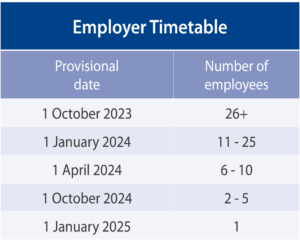Secondary Pensions ‘What’s the latest?’ PDF Article
By Mike Freer at BWCI
“now less clarity
around the launch date”
In a nutshell
Subject to approval of the policy letter and final legislation by the States of Guernsey, every employer will have to automatically enrol their staff into a suitable pension scheme.
April 2022 Announcement
- Subject to States approval, employers with 26 or more staff would need to be compliant by 1 October 2023
- The requirements will continue to be phased in for smaller employers as previously expected, except that the timetable has been pushed back 9 months
- The preferred provider for delivering “Your Island Pension” or “YIP” will be Sovereign Pensions, following the announcement of the withdrawal of Smart Pensions as the preferred provider at the end of 2021.
Background
Guernsey’s Secondary pensions system is designed to provide an additional source of income to supplement the States pension*. It’s been 10 years in the making so far and the deferral of the debate means that there is now less clarity around the launch date. However, there is broad support for the introduction of Secondary Pensions, just less agreement on the timing of its introduction.
* Formerly known as the old age pension
Why is it important?
Secondary pensions is an initiative to tackle the financial challenges of an ageing population. Encouraging people to take more financial responsibility in later life is a key part of the strategy to address the problem.
Following a wide-ranging review of personal tax, pensions and benefits, “Ensuring private pension provision” was identified in 2013 as one of the tools available to mitigate the financial strain of an ageing population on the public purse.
Over the last decade, the UK has introduced and developed a successful workplace pension system. While Guernsey is several years behind, it does mean that we can learn from the UK’s practical experience, before implementing a simpler system, tailored to its working age population.
Who’s affected?
Every employee paying Social Security contributions is potentially included. In 2022 terms, this is everyone earning more than the Lower Earnings Limit of £7,904 pa.
Employees have a choice
Whilst staff will need to be automatically enrolled, the system is only “semi-compulsory”, as employees will have the choice to opt out. However, their employer would need to re-enrol opt-outs again periodically.
Phased introduction
Not all employers will need to comply immediately; a phased introduction is proposed, depending on the size of the workforce. Larger employers would potentially need to be compliant from
1 October 2023. However, this is subject to approval by the States of Guernsey.
Provisional Employer Timetable
(subject to States of Guernsey approval and could be deferred)

How much will it cost?
Contributions will be a percentage of “Gross Earnings” up to the Upper Earnings Limit (£157,404 pa in 2022).
The long-term contribution rates, which will be phased in gradually, are 3.5% for the employer and 6.5% for the employee. However, employers will only have to contribute for employees who have not opted-out. In 2022 terms, the maximum long-term employer contribution for an individual earning in excess of the Upper Earnings Limit would be £5,509 pa; the maximum employee contribution would be £10,231.
Details of how the proposed phasing-in proposals would work are illustrated in the chart. Please note that these dates have not yet been agreed and could be deferred.

Summary of Proposals
(which are subject to final approval from the States of Guernsey)
- A new Secondary Pension system is to be established, supplementing the existing States pension arrangements.
- Employers will need to automatically enrol their staff into a pension scheme.
- Employees can opt out, but will be re-enrolled by their employer periodically.
- Unless an employee has opted out, the employer and the employee must pay a minimum level of contributions.
- The joint employer/employee contribution rate is split roughly 1/3rd employer and 2/3rds employee; the long-term employer and employee rates are 3.5% and 6.5% of gross salary respectively. However, if an employer chose to pay more than the minimum there would then be a corresponding reduction in the employees’ minimum rate.
- Employers must not offer employees inducements to opt out.
We’re here to help
If you have any questions about secondary pensions or would like to talk through the options in your particular circumstances, please contact Mike Freer (mike.freer@bwcigroup.com) or Sarah de Garis (sarah.degaris@bwcigroup.com).
BWCI Pension Trustees Limited, which is regulated as a pension provider by the Guernsey Financial Services Commission, offers a range of services to help employers meet their obligations under secondary pensions, ranging from our Blue Riband suite of positive retirement solutions to a fully bespoke arrangement.


